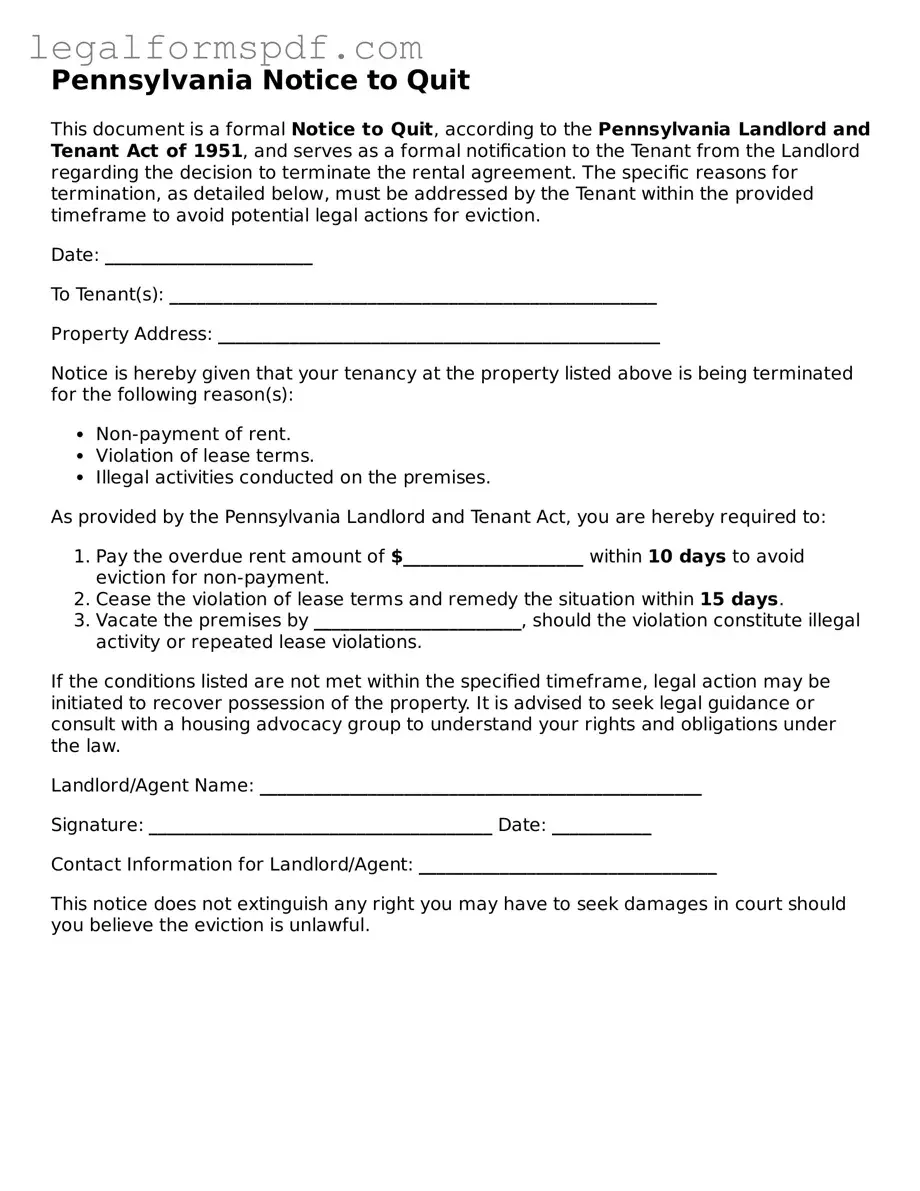The Pennsylvania Notice to Quit form shares similarities with an Eviction Notice in other states, in terms of its fundamental purpose. Both serve as preliminary steps landlords must take to legally evict a tenant, specifying the reasons for eviction, such as non-payment of rent or violation of lease terms. These documents formally alert the tenant of the landlord's intent to terminate the lease if the stipulated conditions are not met within a defined period.
Comparable to a Lease Termination Letter, the Notice to Quit informs the tenant that the rental agreement will end. However, while a Lease Termination Letter may be used under more amicable circumstances or mutual agreement, the Notice to Quit typically precedes a more forceful eviction process, implying legal action if compliance is not achieved.
A Rent Demand Letter is also akin to the Notice to Quit, with both aiming to address issues related to unpaid rent. The key difference lies in their approach and subsequent actions; while a Rent Demand Letter requests the payment of overdue rent, a Notice to Quit may include this demand but primarily serves as a warning of potential eviction should the tenant fail to rectify the breach of lease terms.
Another related document is the Cure or Quit Notice, which, like the Notice to Quit, is used in situations of lease agreement violations. This document specifically allows the tenant a chance to "cure" the violation, such as making repairs or ceasing disruptive behavior, within a given timeframe to avoid eviction, highlighting a pathway to resolve the issue without terminating the lease.
The Notice of Lease Violation shares similarities with the Notice to Quit by informing tenants of violations to their rental agreement. While the Notice of Lease Violation typically serves as a preliminary warning, allowing tenants to correct the issue, the Notice to Quit is a more definitive step towards eviction if the breach is not remedied.
Unconditional Quit Notices, while similar in purpose to the Notice to Quit, leave no room for the tenant to rectify the situation. This document is used in more severe cases, such as repeated violations or significant damage to property, demanding that the tenant vacate the premises without a chance to cure the violation.
Pay or Quit Notices are similar to the Notice to Quit when it comes to issues of unpaid rent. This type of notice specifically demands that the tenant either pay the overdue rent or vacate the premises within a specified period, combining aspects of rent demand with the implication of lease termination.
The Notice to Vacate, often used interchangeably with the Notice to Quit in some jurisdictions, similarly initiates the process of ending the tenant's occupancy of the rental unit. It is typically more broad in its application, not always specifying the grounds for eviction, and may be used for both at-fault and no-fault evictions, depending on local laws.
Last, the 30-Day Notice to Vacate parallels the Notice to Quit in its function to end the tenancy, typically employed when either party decides not to renew a month-to-month lease. It is a formal notification to the other party, giving tenants or landlords the requisite 30 days to prepare for the termination of the rental agreement, though it is not specifically aimed at addressing breaches of the lease.
